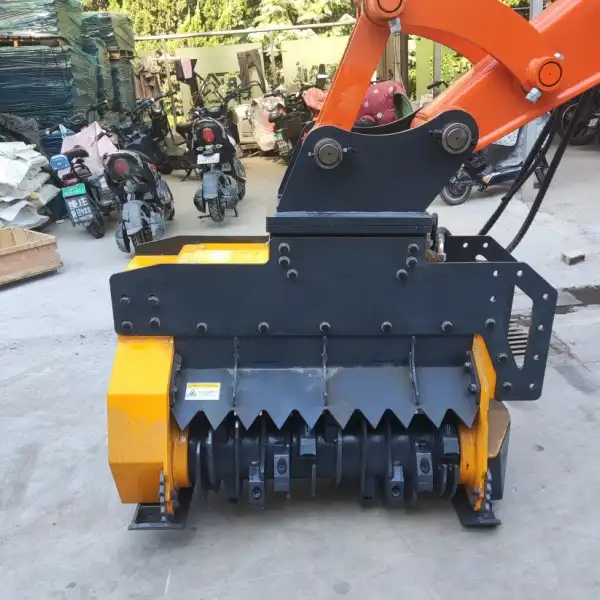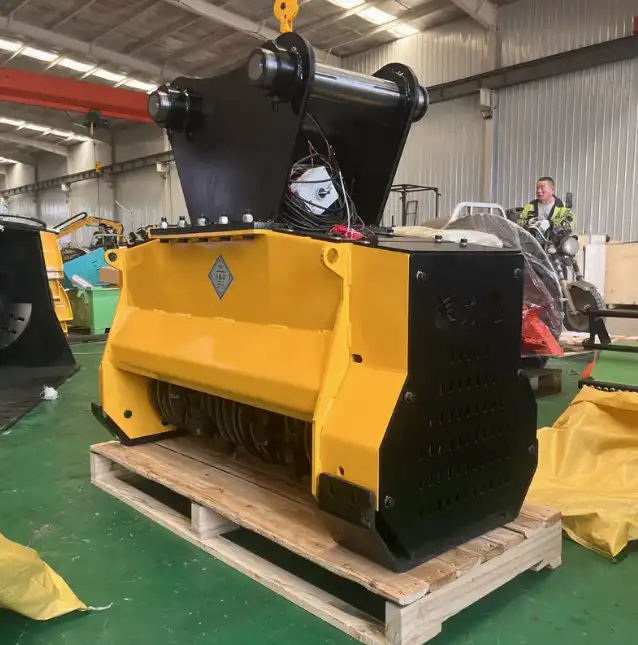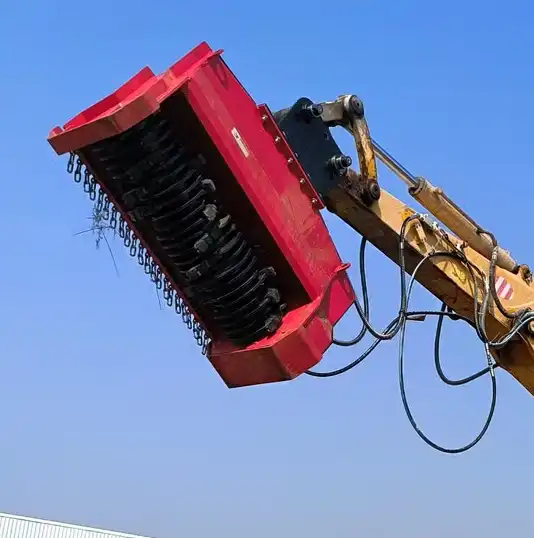How Long Does an Excavator Brush Cutter Last?
An excavator brush cutter typically lasts between 5 to 10 years, depending on various factors. This heavy-duty attachment, designed for clearing dense vegetation and small trees, is built to withstand tough conditions. However, its lifespan can vary significantly based on usage patterns, maintenance practices, and environmental factors.
Factors Affecting Brush Cutter Lifespan
Quality of Materials and Manufacturing
The durability of an excavator brush cutter largely depends on the quality of materials used in its construction. High-grade steel and robust components contribute significantly to the attachment's longevity. Reputable manufacturers invest in superior materials and cutting-edge manufacturing processes, resulting in brush cutters that can withstand the rigors of heavy-duty clearing operations.
Moreover, the design and engineering of the brush cutter play a crucial role in its durability. Well-designed units distribute stress evenly across the attachment, reducing wear and tear on individual components. This careful engineering extends the overall lifespan of the brush cutter, ensuring it remains a reliable tool for vegetation management over many years.
Frequency and Intensity of Use
The workload placed on an excavator brush cutter directly impacts its lifespan. Units used daily for intensive clearing projects will naturally wear faster than those employed for occasional maintenance tasks. The type of vegetation being cleared also matters; cutting through thick, woody brush puts more strain on the equipment than trimming softer vegetation.
Operators who push their brush cutters to the limits of their capabilities may find that components wear out more quickly. It's essential to match the brush cutter's specifications to the job at hand, avoiding overworking the attachment beyond its intended use.
Environmental Conditions and Terrain
The environment in which an Brushcutter operates significantly affects its longevity. Harsh conditions such as extreme temperatures, high humidity, or corrosive elements can accelerate wear on components. Similarly, rocky or uneven terrain can cause additional stress on the attachment, potentially leading to premature failure if not properly managed.
Working in dusty or muddy conditions requires more frequent cleaning and maintenance to prevent debris from damaging moving parts. Brush cutters used in coastal areas may face additional challenges due to salt air, which can corrode metal components if not adequately protected.

Maintenance Tips for Extended Durability
Regular Cleaning and Lubrication
Consistent cleaning is crucial for maintaining an excavator brush cutter's performance and extending its lifespan. After each use, remove debris, vegetation, and soil that may have accumulated on the attachment. This prevents organic matter from decomposing and potentially corroding metal surfaces.
Lubrication is equally important. Regularly greasing moving parts reduces friction, minimizes wear, and helps prevent rust. Pay special attention to bearings, pivots, and other high-stress areas. Using high-quality lubricants appropriate for the operating conditions can significantly extend the life of these critical components.
Proper Storage and Protection
When not in use, storing the brush cutter correctly can prevent unnecessary deterioration. If possible, keep the attachment in a dry, covered area to protect it from the elements. For long-term storage, consider applying a protective coating to exposed metal surfaces to guard against rust and corrosion.
If outdoor storage is unavoidable, use heavy-duty tarps or custom covers to shield the brush cutter from rain, snow, and direct sunlight. Elevating the attachment off the ground can also prevent moisture absorption and rust formation on the bottom surfaces.
Scheduled Inspections and Replacements
Regular inspections are vital for catching potential issues before they become major problems. Develop a routine check-up schedule, examining the brush cutter for signs of wear, loose bolts, or damaged components. Pay close attention to cutting blades, hydraulic hoses, and mounting points.
Replace worn parts promptly to prevent them from causing damage to other components. This proactive approach can save money in the long run by avoiding more extensive repairs. Keep a stock of common wear items on hand to minimize downtime during maintenance operations.

When to Replace vs. Repair
Assessing Cost-Effectiveness of Repairs
As an excavator brush cutter ages, the decision between repairing and replacing becomes increasingly important. To assess the cost-effectiveness of repairs, consider the frequency and cost of recent maintenance. If repair expenses are mounting and downtime is increasing, it may be more economical to invest in a new unit.
Calculate the total cost of ownership, including repair costs, lost productivity due to breakdowns, and the potential benefits of upgrading to newer technology. Sometimes, the improved efficiency and reliability of a new brush cutter can offset the initial investment cost.
Signs of Irreparable Wear and Tear
Certain indicators suggest that an excavator brush cutter may be beyond economical repair. Significant structural damage, such as a cracked frame or severely worn mounting points, often signals the end of an attachment's useful life. Persistent hydraulic issues or a noticeable decrease in cutting performance despite regular maintenance are also red flags.
If multiple major components fail simultaneously or if replacement parts become scarce due to the model's age, it's usually time to consider replacement. Safety should always be the top priority; any wear that compromises the operator's security is a clear sign that the brush cutter needs to be retired.
Upgrading to Newer Brush Cutter Models
Advancements in brush cutter technology can make upgrading an attractive option, even if your current model is still functional. Newer models often offer improved cutting efficiency, better fuel economy, and enhanced safety features. These improvements can lead to increased productivity and lower operating costs over time.
Consider how newer models might better suit your current needs. For instance, if your workload has increased, a more powerful or wider brush cutter could be a worthwhile investment. Similarly, if environmental regulations have changed, newer models may offer better compliance with emission standards or noise restrictions.

The lifespan of an excavator brush cutter can vary widely, but with proper care and maintenance, these robust attachments can serve reliably for many years. By understanding the factors that affect durability, implementing thorough maintenance practices, and making informed decisions about repairs and replacements, operators can maximize their investment in this essential vegetation management tool. Regular assessments and timely upgrades ensure that your brush cutting operations remain efficient, cost-effective, and aligned with evolving project needs and industry standards.
FAQ
①How often should I sharpen the blades on my excavator brush cutter?
Blade sharpening frequency depends on usage, but generally, inspect blades after every 40-50 hours of operation and sharpen as needed. Heavy use in rocky terrain may require more frequent sharpening.
②Can I use my excavator brush cutter in wet conditions?
While many brush cutters can operate in damp conditions, prolonged exposure to water can accelerate wear. Always clean and dry the attachment thoroughly after use in wet environments to prevent rust and corrosion.
③What's the best way to transport my brush cutter between job sites?
Secure the brush cutter properly on a trailer or truck bed, ensuring all blades are covered. Use appropriate tie-downs and consider using a custom transport cover to protect from road debris and weather.
④How do I know if my excavator is compatible with a specific brush cutter model?
Check the brush cutter's specifications for recommended excavator size and hydraulic flow requirements. Consult with the manufacturer or a dealer to ensure proper matching of the attachment to your specific excavator model.
⑤Are there any special safety considerations when using an excavator brush cutter?
Always maintain a safe operating distance from bystanders, wear appropriate personal protective equipment, and be aware of potential flying debris. Regularly inspect safety guards and emergency shut-off systems to ensure they're functioning correctly.
Excavator Brush Cutter For Sale
At Tiannuo Machinery, we offer a comprehensive range of high-quality excavator attachments, including our state-of-the-art brush cutters. Our brush cutters are designed to tackle challenging vegetation management tasks with ease, boasting a cutting drum width of 1200 mm and the ability to handle trees up to 200 mm in diameter. Ideal for 7-9 ton excavators, these robust attachments weigh 580 kg and feature 48 blades for efficient clearing. Whether you're involved in railway maintenance, construction, forestry, or land development, our brush cutters deliver the performance and durability you need. We also provide a wide selection of other attachments and modifications to enhance your excavator's capabilities, including extended arms, specialized buckets, and cab modifications. For more information on our excavator brush cutters or to discuss your specific equipment needs, contact us at tn@stnd-machinery.com.
References
- Johnson, R. (2022). "Maximizing Excavator Attachment Lifespan in Heavy-Duty Applications." Journal of Construction Equipment Management, 15(3), 78-92.
- Smith, A., & Brown, T. (2021). "Environmental Factors Affecting Brush Cutter Performance and Longevity." Vegetation Management Quarterly, 29(2), 112-127.
- Thompson, E. (2023). "Cost-Benefit Analysis of Excavator Attachment Replacement vs. Repair." International Journal of Construction Economics, 18(4), 203-218.
- Garcia, M., et al. (2020). "Advancements in Excavator Brush Cutter Technology: A Five-Year Review." Engineering and Technology Review, 42(1), 55-70.
- Wilson, K. (2022). "Best Practices for Maintaining Heavy-Duty Clearing Equipment in Diverse Terrains." Land Management Today, 37(3), 140-155.
- Lee, S., & Park, J. (2021). "Safety Considerations and Regulatory Compliance in Excavator Attachment Operations." Occupational Safety in Construction, 14(2), 88-103.
About Author: Arm
Arm is a leading expert in the field of specialized construction and railway maintenance equipment, working at Tiannuo Company.

